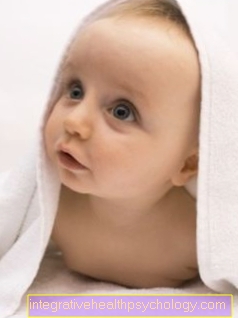Paracetamol
introduction
Paracetamol is a widely used pain reliever (analgesic) from the group of cyclooxygenase inhibitors (non-opioid analgesics) and is used for mild to moderately severe pain of various causes.
It is also used as a fever-lowering drug (antipyretic).
Different dosage forms such as:
- Tablets
- Capsules
- Suppositories
- Infusions
or - juices
are commercially available.
The most common dosage form is 500 mg tablets.

Trade names
- Paracetamol 500 Hexal®
- Ben-u-ron ® 500 mg from Novartis
- Benuron® captin
- Enelfa ®
- Gelonida®
- Grippostad ® C
- Neopyrin ® forte
- Thomapyrin ® C pain tablets
- and much more
Chemical name
Paracetamol (N - acetyl - para - aminophenol)
4'-hydroxyacetanilide
application areas
Paracetamol is used for mild and moderate pain of various causes and to lower fever.
Common areas of application:
- a headache
- Osteoarthritis (e.g. knee osteoarthritis, hip osteoarthritis)
- Back pain
- Toothache
- fever
Paracetamol for fever
Paracetamol usually has a good antipyretic effect. It inhibits the release of prostaglandins. These play a big role in the development of a fever. Prostaglandins usually help structures in the brain to be informed and activated. As a result, it causes a change in temperature in the body. Through various processes, this ultimately leads to a fever. Paracetamol intervenes here.
Also read our topic: How can you lower a fever?
Paracetamol for headache
Paracetamol is more antipyretic than pain reliever. Therefore, in some cases, the active ingredient can insufficiently relieve headaches. However, the effect is very individual. Therefore, one cannot generally say that paracetamol has a bad effect on headaches. A combination of acetylsalicylic acid, paracetamol and coffee is also recommended by the Headache League. This combination is said to help reduce migraines. In some cases this seems effective. However, so-called "analgesic headaches" are sometimes observed even with low-dose, long-term consumption of paracetamol. In these cases, other pain relievers or headache measures must be used.
Paracetamol for toothache
The same applies here as for headaches. Since paracetamol reacts very differently, it can have a soothing effect or possibly not at all.
Dosage form
- Tablets / film-coated tablets
- Capsules
- juice
- Suppositories / suppositories
- syrup
effect
Paracetamol has an antipyretic and analgesic effect by inhibiting the production of prostaglandin in the body cells.
Prostaglandines are so-called pain mediators that regulate functions such as pain, inflammation and fever. Prostaglandins also affect the Blood clotting. Of the However, the influence of paracetamol on blood coagulation is comparatively small (e.g. in comparison with Acetylsalicylic acid = ASS 100 = Aspirin®).
The same is true very little anti-inflammatory effect.
application
Long-term use of paracetamol should not be done without consulting your doctor.
Paracetamol should be swallowed whole with plenty of liquid. Taking after meals can delay the onset of action.
Paracetamol as a suppository
Paracetamol can also be given as a suppository. This type of application is often preferred, particularly when using paracetamol in infants, toddlers and children. Infants and young children can often have a fever and home remedies are not always sufficient. However, babies and toddlers are usually not yet able to swallow tablets with liquid. Therefore, the suppositories are a welcome alternative. There are specially low-dose preparations for different age groups.
Also read our topic: Paracetamol as a suppository
dosage
Depending on the painful situation, paracetamol can be taken in 3-4 single doses per day.
The maximum dose for adults is a maximum of 8 tablets (500 mg) daily, corresponding to 4000 milligrams of paracetamol.
Overdosing with paracetamol can lead to life-threatening liver damage!
Dosage in children:
Depending on age or body weight, usually 10-15 mg per kg body weight as a single dose, max. up to 50 mg per kg body weight / day. The gift can be given at intervals of 6-8 hours to be repeated, i.e. H. 3 - 4 single doses / day
Maximum dose of paracetamol
In adults, the maximum dose is between 0.5-3 g per day. Due to individual circumstances and influencing factors, the maximum dose is not specified individually. The limit from when paracetamol has a toxic effect on the body varies. However, under no circumstances should a dose of 5 g be exceeded. Children are more sensitive to medication. Therefore, the maximum dose based on body weight is given here. In children, therefore, the dose of 50 mg per kg of body weight should never be exceeded.
Side effects
Paracetamol is a well tolerated drug. Frequent side effects do not occur when used properly.
Rare to very rare side effects are:
- Disorder of blood formation
- Allergic reaction
- Abdominal pain / nausea
- Increase in liver enzymes
- Cramping of the airways / shortness of breath
Read more on the topic: Paracetamol and alcohol - are they compatible ?, Painkillers for liver diseases
Side effect on the liver
The active ingredient is completely metabolized in the liver after about 2 hours. If the doses are exceeded or in combination with alcohol, acute poisoning can occur. In these cases the liver can be irreversibly damaged.
Please also read: Pain relievers for liver diseases
Side effect on the kidney
Paracetamol is eliminated through the kidneys. If the kidneys are stressed regularly and continuously, this can cause damage. Paracetamol also inhibits the effects of prostaglandins and prostacyclins in the kidney. This can lead to poor blood flow to the kidney. As a result, the kidney's filtering function is at risk. Chronic abuse can result in kidney damage.
Paracetamol poisoning
In the event of acute poisoning, the liver can no longer metabolize and break down the active paracetamol. In these cases, the body's own glutathione is used up. Acute liver damage occurs. The antidote for acute paracetamol poisoning is acetylcysteine. Like glutathione, it has so-called SH groups. This property enables acetylcysteine to bind the toxic substances and then excrete them through the kidneys. If you suspect poisoning with paracetamol, you should consult a doctor immediately.
Paracetamol in pregnancy
The guidelines allow the use of paracetamol during pregnancy. If a pain reliever has to be used during pregnancy, paracetamol is the first choice according to guidelines. However, the intake should be kept as low as possible. Regular consumption should be avoided. The recommendations are based on experience. Since the mechanism of action of paracetamol is not yet fully understood, it is difficult to assess its effects on the embryo. Recently it has been increasingly suspected that there may be a connection between ADHD and the use of paracetamol during pregnancy. It is still unclear whether and how there are connections or whether there are other connections. These assumptions have not yet been proven. It is generally recommended to decide on the benefit-harm ratio for the expectant mother and the unborn child. There should be an exchange about it with the gynecologist.
Also read our topic: Paracetamol in pregnancy
Paracetamol while breastfeeding
Many authors consider it safe to take paracetamol while breastfeeding. According to them, there has been experience for 40 years that made paracetamol the first choice for breastfeeding. Other authors see it differently. They suspect links between ADHD and paracetamol use during pregnancy and breastfeeding. However, these assumptions have not yet been scientifically proven. In any case, a maximum dose should never be exceeded. This maximum dose is different during breastfeeding than outside breastfeeding. Single doses of a maximum of 1000 mg and a maximum daily dose of 2000 mg are recommended. It is not recommended to take paracetamol regularly while breastfeeding, even if it is used in low doses. You shouldn't take paracetamol for more than three days straight. At best, you should consult your gynecologist before taking any medication while breastfeeding. It is believed that at a dose of 1000 mg, the infant receives 1.85% of the dose from the mother. No effects have been sufficiently proven in studies. But whether this dose actually has no effects has not been fully established. In any case, it is important to ensure that the preparation only contains paracetamol. Some preparations also contain acetylsalicylic acid or codeine. Neither of these should get into the baby through breast milk.
Further information on this topic can be found at: Paracetamol while breastfeeding
Paracetamol and alcohol - are they compatible?
Since both paracetamol and alcohol are broken down in the liver, acute or chronic reactions can occur. It is recommended that you avoid alcohol while taking paracetamol. Alcohol sickness is a contraindication to taking paracetamol. This can be explained by the breakdown of paracetamol in the liver. This creates a toxic product, the so-called N-acetyl-p-benzoquinone imine (NAPQI). As a rule, this substance is bound by the body's own substance glutathione and excreted via the kidneys. However, the supplies of the glutathione are limited. If the liver is busy breaking down alcohol at the same time, this can overload the organ. This does not even have to be an overdose of paracetamol. The destruction of the liver as a detoxification organ can have damaging effects on the whole body. In addition, one does not yet know exactly how paracetamol works in our body. It is believed that, among other things, it affects the messenger substance serotonin in the brain and other parts of the body. It is possible that paracetamol inhibits the enzyme COX 2 particularly strongly in our brain. This inhibition could have an influence on the pain transmission. Among other things, alcohol also activates serotonin receptors, which presumably trigger alcohol-induced vomiting. In addition, alcohol also has an influence on the transmission of pain. It is difficult to assess to what extent a combination of alcohol and paracetamol affects the neurotransmitter balance and the body's energy balance in the short or long term. Therefore, when combining the drug with alcohol, unforeseeable reversible and irreversible discomfort and damage to various organs can occur.
If you are interested in this topic, please also read: Paracetamol and alcohol - are they compatible?
Paracetamol vs. Ibuprofen - What's the Difference?
Paracetamol and ibuprofen are both so-called non-opioid analgesics. That means they are both pain relievers that do not belong to the group of opiates. They both intervene in the so-called prostaglandin synthesis. Paracetamol is one of the pain relievers that are non-acidic. Ibubrofen is something called an acidic pain reliever. That said, paracetamol is not an acid, while ibuprofen is a weak acid. As a result, ibuprofen has an anti-inflammatory effect. This is known as the anti-inflammatory effect. Paracetamol does not have this ability. Since ibuprofen is an acid, it can penetrate into inflamed tissue. In healthy tissue there is a pH of around 7.4. At this pH value, ibuprofen can hardly cross the cell membrane. In the inflamed tissue, however, the pH value is lower, i.e. more acidic. Now the ibuprofen can pass through the cell membrane and accumulate in the cell. It can develop its anti-inflammatory effect there. This is not possible with the non-acidic paracetamol. Both substances have an analgesic and antipyretic effect. Paracetamol is more effective in lowering fever than pain reliever. The good fever-lowering effect of paracetamol is characteristic of this active ingredient. Ibuprofen inhibits the enzymes Cox1 and Cox 2 equally.The effect seems to be more in the whole body than in the brain. The mechanism of action of paracetamol is not yet fully understood. It is believed, however, that it works more strongly in the brain.
Find out more at: Does paracetamol have anti-inflammatory effects?
Interactions
In the case of alcohol abuse or the simultaneous use of substances that damage the liver (e.g. certain sleeping pills, anti-epileptic drugs, etc.), paracetamol Liver damage caused.
The elimination of certain drugs (e.g. Chloramphenicol) can be slowed down.
The onset of action of paracetamol can be accelerated or slowed down by the simultaneous use of other drugs for faster or slower gastric emptying.
Laboratory tests such as the blood sugar test or the uric acid test can be influenced.
Always read the package insert for your paracetamol drug!
Contraindications
Who must / should not take paracetamol:
Patients with an allergy to the active ingredient paracetamol or other drug components.
- Patients with severe liver impairment
- Patients with severe kidney impairment
- Patients during pregnancy and breastfeeding ((see also: Paracetamol during breastfeeding) can be taken, but always as short as possible and only in consultation with the doctor).
More on this topic at: Medication during pregnancy
price
Since there is always talk of cost pressure in the healthcare sector, we believe it is important to also find out prices for drugs (prices are exemplary and not recommended):
Paracetamol 500 HEXAL® tablets 30 tablets (N2) € 1.69
Benuron® tablets 10 tablets (N1) € 1.31
Benuron® tablets 20 tablets (N2) € 1.91
Benuron® tablets 50 tablets (N3) € 4.00
Status: Jun. 05
Prescription requirement
There is no prescription requirement for all dosages!
Does paracetamol thin the blood?
Paracetamol probably inhibits the enzymes cyclooxygenases, especially in the brain. Therefore, the effect on blood clotting is probably not as pronounced. Its blood-thinning effect is in any case not sufficient and suitable to be used as a blood thinner. Paracetamol should only be combined with other blood-thinning medications to a limited extent.



























.jpg)

